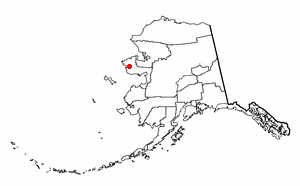Mary's Igloo, Alaska facts for kids
Mary's Igloo (called Qawiaraq or Aġviġnaq in the Iñupiaq language) is a village in Alaska where no one lives permanently anymore. It is now used as a seasonal camp for fishing. Many people who used to live there, and their families, now live in nearby towns like Teller or Nome.
Contents
History of Mary's Igloo
The Inupiat village of Kauwerak was located about 15 miles (24 km) downriver from where Mary's Igloo is today. By 1900, people had left Kauwerak. Most of its residents moved to Teller or Nome to find schools and jobs. A few people settled at the site of Mary's Igloo. They called this new place Aukvaunlook (Aġviġnaq), which means "black whale."
Gold Rush Era and Growth
In the early 1900s, during the time of the gold rush, people who were not Native Alaskans named the village "Mary's Igloo." They named it after an Inupiaq woman named Mary. She was known for welcoming gold miners, trappers, and other travelers into her home for coffee.
During this period, Mary's Igloo became an important stop for supplies. These supplies were for the gold fields located upriver on the Kuzitrin and Kougarok rivers. Large boats brought supplies to Mary's Igloo. Then, the supplies were moved onto smaller boats called barges, which were towed further upriver.
A post office and a store opened in Mary's Igloo in 1901. By 1910, the community had 141 people. These included Inupiat people and Anglo-Americans. They worked as miners, innkeepers, missionaries, and support crews for the barges. The village had schools, a post office, and other services.
Challenges and Abandonment
The community faced hard times in the 1910s and 1920s. A terrible flu sickness spread in 1918 and 1919. Then, a tuberculosis sickness followed two years later. These illnesses caused many people in the village to die. Catholic and Lutheran churches opened orphanages nearby to care for the children who lost their parents.
Because there were fewer students, the schools in Mary's Igloo closed in 1948 and 1950. The post office and store also closed in 1952. Most of the remaining residents moved to Nome or Teller.
Today, no one lives in Mary's Igloo all year round. People from Teller still use the site as a seasonal fish camp during certain times of the year.
Population Changes
| Historical population | |||
|---|---|---|---|
| Census | Pop. | %± | |
| 1910 | 141 | — | |
| 1920 | 115 | −18.4% | |
| 1930 | 113 | −1.7% | |
| 1940 | 114 | 0.9% | |
| 1950 | 64 | −43.9% | |
| 1980 | 0 | — | |
| 1990 | 0 | — | |
| 2000 | 0 | — | |
| 2010 | 0 | — | |
| U.S. Decennial Census | |||
Mary's Igloo first appeared on the U.S. Census in 1910. It was listed as "Igloo," a village not officially part of a city or town. It was not officially called "Mary's Igloo" on the census until 1950. After 1950, it did not appear on the census again until 1980, when its population was zero. It has not reported any residents since then.
Geography of Mary's Igloo
Mary's Igloo is located at 65°09′N 165°04′W / 65.150°N 165.067°W. It sits on the northwest bank of the Kuzitrin River, on the Seward Peninsula in Alaska. It is northeast of Nome and about 40 miles (65 km) southeast of Teller.


